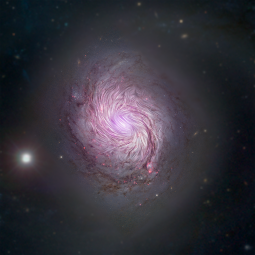By Enrique Lopez-Rodriguez and Joan Schmelz
Paper:
SOFIA/HAWC+ Traces the Magnetic Felds in NGC 1068
Lopez-Rodriguez et al., 2020, ApJ, 888, 66.
SOFIA astronomers have measured, for the first time, the magnetic field tracing the star forming regions along the spiral arms of NGC 1068, the nearest grand-design spiral with an active galactic nuclei and a large-scale almost face-on disk.
The HAWC+ instrument onboard SOFIA provides a new approach to study magnetic fields in galaxies. Far-infrared polarimetry of magnetically aligned dust grains provides measurements of the kiloparsec-scale fields in dense regions of the interstellar medium where star formation occurs.
Although magnetic fields have been measured in galaxies for several decades, these results have been limited to the radio and optical bands. In the radio, synchrotron polarization traces the magnetic fields ‘illuminated’ by relativistic electrons. In the optical, starlight is extinguished by the diffuse interstellar dust. The HAWC+ observations in the far infrared add a complementary new dimension to these studies.
SOFIA researchers were able to combine these new observations with other tracers to confirm a prediction of the density wave theory. This theory predicts that stars form in the arms as gas moves into the wave and is compressed by its gravitational potential. Under this scenario, the spiral arms should look slightly different for several tracers because they appear at different phases of the wave. The spiral traces existing stars in the optical, the inter-arm diffuse medium in the radio, and ongoing star formation in the far infrared. This is the field seen by HAWC+.
Magnetic fields are present at all spatial scales and in all astrophysical sources observed to date in the nearby universe. Astronomers now understand that magnetic fields play a crucial role in the star formation and general dynamics of the Milky Way. These magnetic fields are strong enough to influence the distribution and structure of the gas across the interstellar medium. Thus, the characterization of observations like those from HAWC+ allows astronomers to study how magnetic fields affect and influence different astrophysical environments.
However, the role of magnetic fields in other galaxies is not well understood. Further multi-wavelength observations of different galaxy types are necessary to get a more comprehensive picture of how magnetic fields influence the formation and evolution of galaxies. Together with other observatories, SOFIA/HAWC+ can provide this empirical picture.
